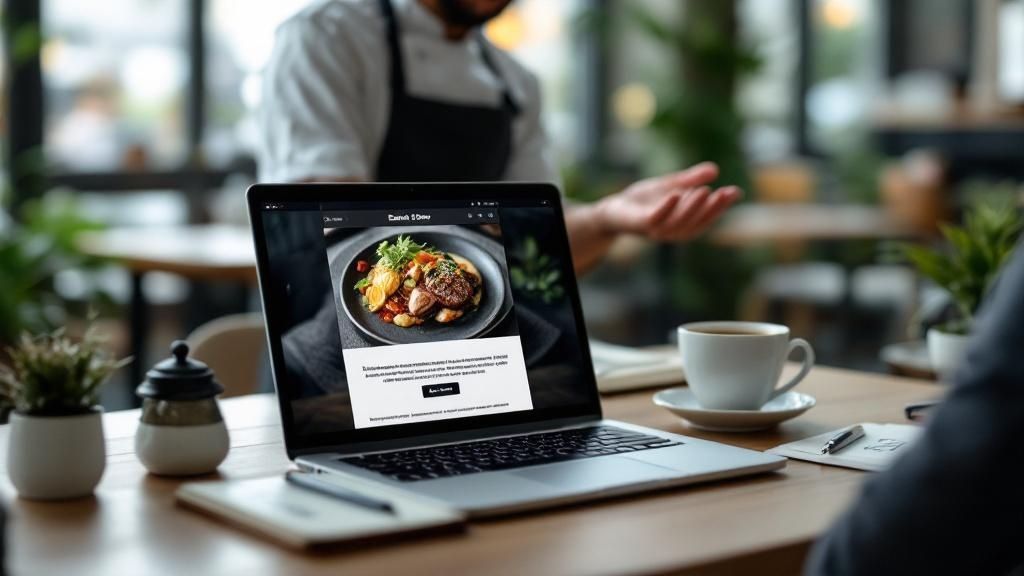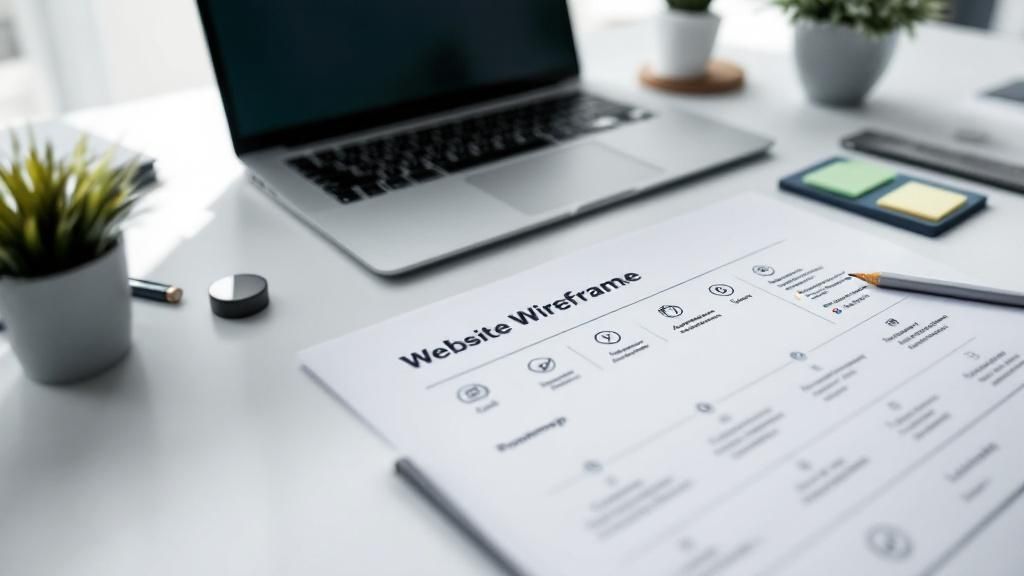Email marketing is a surprisingly powerful way to connect with your customers, turning one-time diners into regulars who can’t wait to come back. It gives you a direct, reliable channel to announce new menus, share special offers, and build genuine relationships—all without being at the mercy of unpredictable social media algorithms. This direct line to your guests’ inboxes is your secret ingredient for boosting repeat business and driving real, sustainable growth.
Why Email Is Your Restaurant’s Secret Ingredient

In the crowded hospitality world, owning your audience is everything. Sure, social media platforms are great for getting discovered, but you’re essentially just renting space. Algorithms change on a whim, your reach can plummet overnight, and you’re always fighting for a sliver of attention. Email marketing for restaurants completely flips that dynamic.
Think of your email list as your restaurant’s exclusive guest list. It’s a direct channel to your most valuable patrons—people who have already walked through your doors, loved your food, and willingly gave you their email. This is an asset you completely own and control, making it one of the most stable and effective marketing tools you can have.
Building a Foundation of Loyalty and Control
The real magic of email marketing lies in customer retention. We all know it costs far more to attract a new customer than it does to convince an existing one to return. Your email list is full of people who’ve already done the hard part: they chose you once. Your job now is just to remind them of that great experience and give them a compelling reason to do it again.
This is about more than just slinging discounts. It’s your chance to build a real connection. Share behind-the-scenes stories, introduce your head chef, or explain the local farm where you source your ingredients. This kind of content transforms your restaurant from just a place to eat into a brand with a personality people feel connected to.
A well-timed email with a special offer, a peek at a new menu item, or an exclusive event invitation can be the gentle nudge a customer needs to make another booking. In fact, research consistently shows that marketing emails directly influence the buying decisions of most consumers.
The Tangible Benefits of a Strong Email Strategy
A consistent email strategy delivers real, measurable results that go way beyond likes and shares. To get a solid grasp of what makes email so effective, it’s worth diving into the latest email marketing best practices to see how these fundamentals work across all industries.
For your restaurant, the advantages are direct and clear:
- Boosted Repeat Business: Special promotions, loyalty rewards, and personalised birthday offers give diners a powerful incentive to come back for more.
- Increased Customer Engagement: Regular, valuable updates keep your restaurant top-of-mind, making diners more likely to think of you when they’re deciding where to eat out.
- Cost-Effective Marketing: Compared to paid advertising, email offers an exceptional return on investment. It’s an affordable way to reach your most qualified audience and directly drive revenue.
- Direct Communication: Unlike social media, there’s no gatekeeper deciding who sees your message. Your announcements and offers land right in your subscribers’ inboxes.
By focusing on this powerful channel, you’re not just sending emails; you’re nurturing relationships that pay dividends in loyalty and sales. Understanding how a targeted approach can drive growth is key, and you can learn more about how to turn your email marketing into customer sales to maximise your efforts.
Building Your Guest List From Scratch
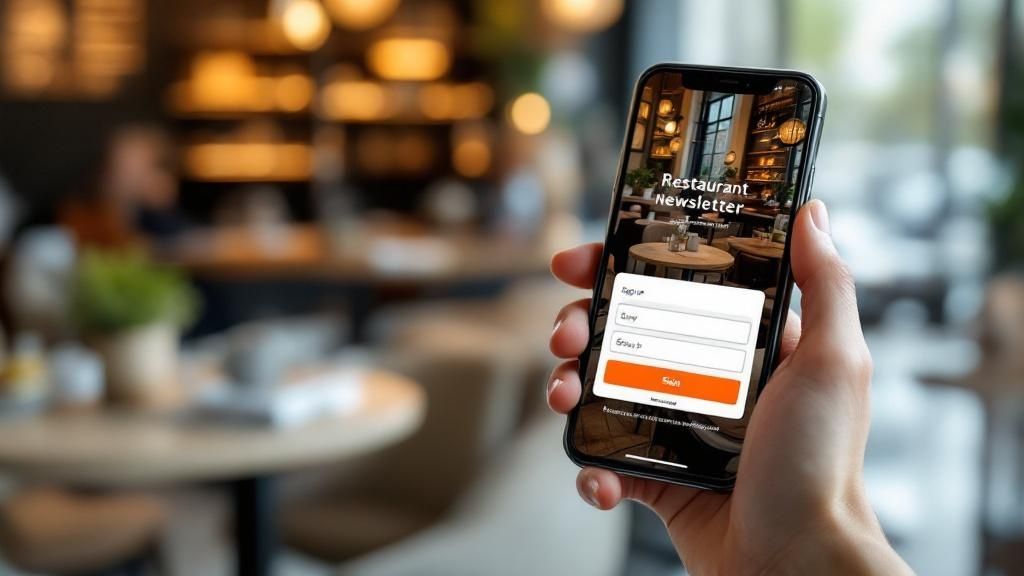
Any great restaurant email strategy starts with a quality guest list—not just a list of names, but a community of diners who genuinely want to hear from you. Forget buying lists or dodgy tactics. The best email addresses come from people who choose to sign up.
It all boils down to a simple value exchange. You need to give them something worthwhile to make sharing their email an easy decision. This isn’t about tricking anyone; it’s the first step in building a real relationship where both you and your guests get something out of it.
Smart In-Venue Collection Methods
Your restaurant itself is the perfect place to grow your email list. Guests are already there, enjoying your brand, so the key is to make signing up seamless and appealing.
- QR Codes on Menus and Tables: Pop a simple QR code on your menus or table tents with an irresistible offer. Something like, “Scan here for a free dessert on your next visit,” makes the process quick, easy, and genuinely rewarding for your guest.
- Guest Wi-Fi Portals: If you offer free Wi-Fi, you’re sitting on a goldmine. Just integrate a simple email sign-up form into the login portal. They get a service they value, and you get a direct line for future promos. It’s a win-win.
- Staff-Driven Sign-ups: Your front-of-house team can be your best brand ambassadors. A friendly, simple question at the end of the meal, like, “Would you like to join our VIP list for exclusive offers?” is incredibly effective.
These on-site strategies work because you’re catching people at the peak of their experience. They’re already happy with your food and vibe, which makes them far more likely to want to stay in touch. To explore more ways to boost your bottom line, check out our guide on https://titanblue.com.au/how-to-increase-restaurant-sales/.
The core idea is always to offer something of value. Whether it’s a discount, a free item, or insider access, a small incentive can produce a significant return by building a list of engaged, loyal customers.
Expanding Your List with Online Strategies
Your digital presence is another powerful engine for collecting emails, reaching potential guests even when they aren’t in your restaurant.
- Website Sign-Up Forms: Make it impossible to miss. Place a clear sign-up form on your homepage or in a pop-up. Give them a reason to join, like, “Get 10% off your first online order when you join our mailing list.”
- Online Reservation Integration: Your booking system is a natural collection point. Just add a simple opt-in checkbox to the reservation process, letting guests choose to receive updates and offers.
- Social Media Giveaways: Run a fun competition on Instagram or Facebook. Requiring an email for entry is a common and effective tactic, especially when the prize is a dinner for two or a gift card.
Of course, once you start building that list, you need to keep it healthy. Knowing how to clean your email list is crucial for making sure your messages actually land in front of your subscribers. After all, a clean list is the bedrock of a successful email program.
Crafting Your Menu of Email Campaigns
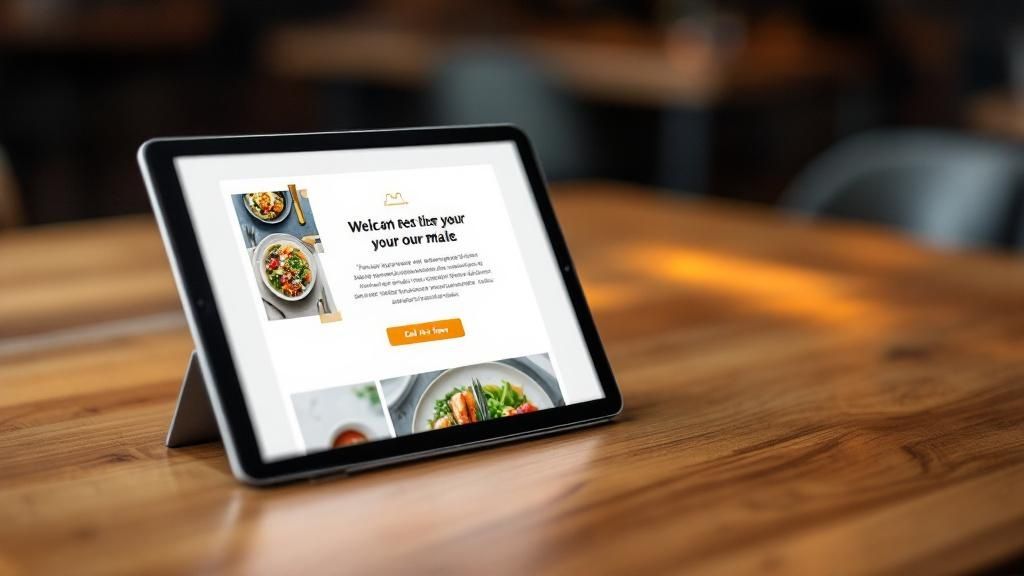
Once your guest list starts to fill up, it’s time to put on your chef’s hat and design a ‘menu’ of email campaigns. A one-size-fits-all email just won’t cut it; different occasions call for different flavours. Really effective email marketing for restaurants is about serving up a variety of messages that speak to different customer moods and keep them coming back for more.
Think of it like your restaurant’s menu. You have appetisers, mains, and desserts. Your email strategy needs that same kind of variety, with each campaign designed for a specific purpose. This keeps your communication fresh, relevant, and genuinely welcome in your subscribers’ inboxes, so they don’t just tune you out.
The Essential Welcome Series
First impressions are everything, right? A welcome series is your digital handshake. It’s an automated sequence of emails that land in a new subscriber’s inbox the moment they sign up. The goal is simple: confirm their subscription, deliver any freebies you promised (like a discount), and give them a taste of your restaurant’s personality.
This is your golden opportunity to set the tone. The first email should arrive instantly, thanking them for joining and maybe sharing a quick story about your restaurant. A few days later, you could send another one highlighting your most popular dishes or introducing your head chef. It makes new subscribers feel like insiders from day one.
The Monthly Newsletter
Your monthly newsletter is the main course of your email strategy. It’s a regular, content-rich email that keeps your restaurant top-of-mind without constantly screaming “buy now!” Think of it as a friendly update from their favourite local spot.
A great newsletter is more than just a list of specials. It’s your chance to tell stories and build a real connection with your diners.
- Behind-the-Scenes Content: Share the inspiration behind a new dish, a story about your local produce supplier, or introduce a valued team member.
- Upcoming Events: Announce special tasting menus, holiday dinners, or live music nights to build a bit of buzz and drive bookings.
- Community Involvement: Highlight your part in local events or charity drives. It shows your restaurant is a proud part of the community fabric.
When you’re pulling these campaigns together, understanding the art of writing a good newsletter that people actually want to read is what separates the pros from the amateurs. It turns your emails from ads into something your subscribers genuinely look forward to.
Promotional and Special Offer Emails
While storytelling builds your brand, promotional emails are all about driving immediate action. These are your specials, your limited-time offers, and those irresistible deals that get people to book a table or place an order right now.
The trick to a good promotional email is creating a sense of genuine value and urgency. You want to frame your offers as exclusive perks for your loyal subscribers, like early access to a new menu or a deal they won’t find anywhere else.
For example, a “2-for-1 Mains on Tuesday” email can help you fill seats on what’s usually a quiet night. A “Flash Sale: 20% Off Takeaway This Weekend” can give your online order numbers a serious boost. Always make your call-to-action—like “Book Your Table” or “Order Now”—big, bold, and unmissable.
Personalised Celebration Emails
Honestly, nothing makes a customer feel more valued than a personal message on their special day. Automated birthday and anniversary emails are absolute gold for building loyalty. You can set them up to run automatically based on the info you collect at sign-up.
A simple, “Happy Birthday, [Customer Name]! Celebrate with a complimentary dessert on us” is a personal touch that creates a real emotional connection. It shows you see your customers as people, not just numbers on a list.
Here in the Australian restaurant scene, this level of personalisation has a massive impact. In fact, personalised, automated emails can generate 12 times more revenue per send than generic mass emails. It just goes to show that tailoring your messages is a powerful way to get customers to spend more. This focus on the individual experience is a big reason why so many Australian diners actually prefer getting emails from restaurants.
The Art of Knowing Your Diners
Sending the same generic email to every single person on your list? That’s like a chef serving every diner the exact same meal, completely ignoring their tastes or dietary needs. Truly effective email marketing for restaurants goes way beyond this one-size-fits-all approach. It’s about getting to know your audience and making your communication feel personal and genuinely relevant.
This is where a powerful concept called audience segmentation comes into play. Think of it like a chef creating a custom tasting menu for a special guest—that’s the level of care you’re aiming for. By dividing your email list into smaller, more specific groups, you can send messages that actually resonate, making every subscriber feel seen and valued.
Segmentation is what turns a generic broadcast into a meaningful conversation. It transforms your email list from a simple database into a powerful relationship-building tool.
This isn’t just about being thoughtful; it’s about getting real business results. Personalised campaigns are far more likely to be opened, clicked, and acted upon, which leads directly to more bookings and more orders. It’s the difference between shouting into a crowd and pulling someone aside for a quiet, one-on-one chat.
Tapping into Your Data Goldmine
Here’s the best part: you’re probably already sitting on a treasure trove of the data you need to get started. Your Point of Sale (POS) and online booking systems are packed with customer information. By connecting these systems to your email platform, you can begin grouping subscribers based on what they actually do.
This data lets you create incredibly effective segments without having to manually survey every customer. You can automatically pinpoint your most valuable patrons, understand their habits, and craft offers that feel like they were made just for them. It’s simply a smarter, more efficient way to handle your marketing.
Practical Ways to Segment Your Restaurant’s Audience
Let’s break down some of the most impactful ways to slice and dice your email list. Each of these groups allows you to build hyper-relevant campaigns that speak directly to your diners’ experiences and preferences.
- Visit Frequency: This is one of the most fundamental segments. You can create groups like First-Time Diners, Occasional Visitors (who haven’t popped in for 90 days), and Loyal Regulars (who visit at least once a month). A first-timer could get a warm welcome offer, while a regular might receive an exclusive preview of a new menu item.
- Spending Habits: Your POS data can easily tell you who your big spenders are. You can create a VIP Segment for guests who consistently have a high average spend. These are the people you can invite to exclusive wine-tasting events or offer premium specials, rewarding their loyalty and encouraging more high-value visits.
- Order History & Preferences: Take a look at what your customers actually order. You might have a group of Wine Lovers who always add a bottle to their meal, or Family Diners who often order from the kids’ menu. This lets you send a targeted email about your new wine list to the oenophiles, or a family meal deal to the parents.
By organising your audience this way, you give every email the best possible chance of hitting the mark. This diagram shows the key metrics you’ll use to measure whether these targeted messages are actually working.
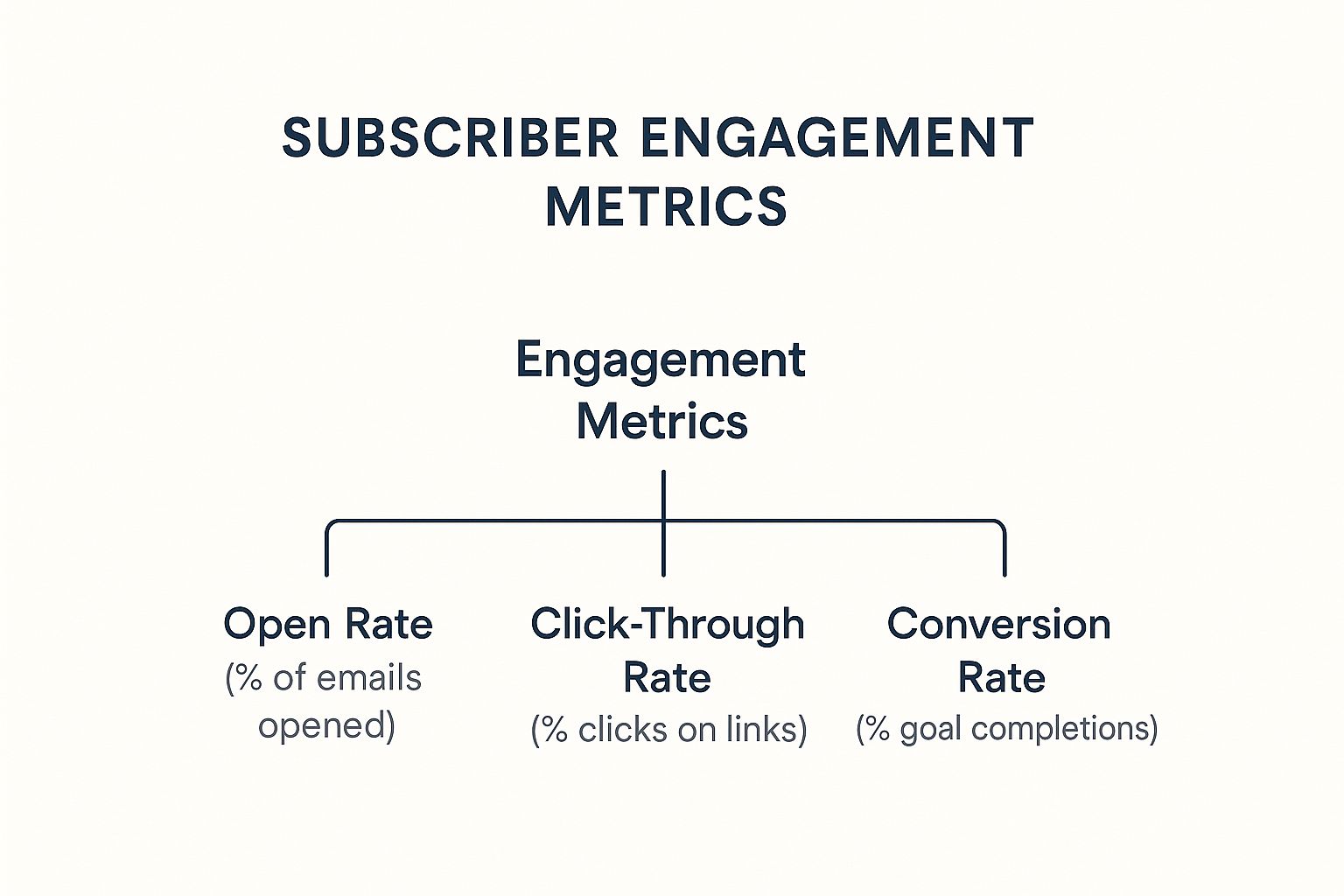
This hierarchy breaks down how you measure engagement, starting from the moment someone opens your email all the way to a successful booking or order.
Putting Segmentation into Action
Once you have your segments defined, the real fun begins. Now you can craft campaigns with surgical precision, delivering value that feels truly personal.
- Re-engaging Lapsed Customers: Set up a segment for diners who haven’t visited in over three months. Send them a friendly “We Miss You!” campaign with a compelling reason to come back, like 15% off their next meal, to tempt them back through your doors.
- Celebrating Your VIPs: Your VIP segment deserves the red-carpet treatment. Send them exclusive, non-public offers they can’t get anywhere else. Think early access to holiday bookings or a complimentary glass of prosecco on their next visit to show them how much you appreciate their business.
- Targeting Dietary Needs: If your data reveals a group of customers who consistently order vegetarian or gluten-free dishes, you can create a specific segment just for them. When you launch a new plant-based menu, they should be the very first to hear about it.
This level of detailed targeting is what separates good email marketing from great email marketing. It shows your customers that you’re paying attention not just to their wallets, but to their individual tastes and habits.
Essential Ingredients for Emails That Work
https://www.youtube.com/embed/AJGtpQ6h9FA
Once you have your campaign ideas and audience segments organised, it’s time to get into the nitty-gritty details that make an email actually work. These are the non-negotiable elements that make sure your messages get opened, read, and acted upon. Think of them as the essential ingredients in a recipe; miss one, and the final dish just won’t taste right.
Great email marketing for restaurants comes down to mastering these fundamentals. Every single element plays a part, from the moment an email lands in an inbox to the final click on your booking link.
Write Subject Lines That Cut Through the Clutter
Your subject line is your digital shopfront window. It has one job: to be compelling enough to make someone stop scrolling and click. With inboxes more crowded than ever, a generic or boring subject line is a guaranteed ticket to being ignored.
To make yours stand out, keep it short, create a sense of urgency, and hint at the value waiting inside. A well-placed emoji can also add a splash of personality and grab attention. Here are a few examples that work:
- “Got plans this weekend? We do.” to spark curiosity.
- “Your Exclusive 20% Off Offer Inside” to be direct and valuable.
- “Final Hours to Book for Mother’s Day!” to create urgency.
Don’t forget the preheader text—that little snippet you see right next to the subject line. It’s your secret weapon. Use it to expand on your offer, not just repeat what you’ve already said. For instance, a subject line like “A Treat Just For You” works beautifully with a preheader like, “Claim your complimentary dessert before it’s gone!”
Use High-Quality, Mouth-Watering Visuals
People eat with their eyes first, and the exact same rule applies to your emails. Blurry, low-quality photos will do more harm than good, making your restaurant look amateurish. Your emails need to feature high-quality, professional-looking images of your food, your restaurant’s atmosphere, and even your team.
These visuals do more than just make your email look good; they evoke emotion and create desire. A stunning photo of your signature pasta dish can be far more persuasive than paragraphs of descriptive text ever could be. It’s a core part of building your brand’s unique voice and making your offers impossible to resist.
A well-crafted email is a multi-sensory experience delivered digitally. The words provide the flavour and context, but the images provide the immediate, mouth-watering appeal that drives a diner to take action.
When it comes to the technical side of things, there are a few elements that are simply non-negotiable. For a deeper dive, exploring a guide on email marketing best practices for success can provide a solid foundation for your strategy.
Build a Mobile-First, Action-Oriented Design
Let’s be real: most of your subscribers will read your emails on their phones, probably while they’re on the go. If your email isn’t optimised for mobile, you’ve already lost. This means using a single-column layout, large fonts, and buttons that are easy to tap with a thumb. No one wants to pinch and zoom just to read your menu special.
Every email must have a single, crystal-clear call-to-action (CTA). Don’t confuse people by asking them to do three different things. Whether it’s “Book Your Table,” “Order Now,” or “View Our New Menu,” make it completely obvious what you want them to do next.
Finally, you absolutely must follow Australia’s anti-spam laws, primarily the Spam Act 2003. This means you need permission to email someone and you must always include a clear, functional unsubscribe link. Following these rules isn’t just about compliance; it’s about building trust and showing respect for your audience.
The wider business-to-consumer marketing landscape in Australia confirms the power of this channel. While restaurant-specific data can be scarce, global trends show email marketing revenue is expected to hit $17.9 billion by 2027, with a staggering return of $36 for every $1 spent. These figures highlight the huge potential for Australian restaurants to drive loyalty and revenue through well-executed email campaigns. You can discover more B2C email marketing insights on apteco.com to see the bigger picture.
Your Questions on Restaurant Email Marketing Answered
Diving into a new marketing strategy always brings up a few questions. When it comes to email marketing for restaurants, I find most owners have similar thoughts circling around how often to send emails, whether it actually works, and what it’s going to cost.
Let’s clear the air on some of the most common queries. Think of this as a quick chat to settle any doubts, showing you just how doable and powerful a good email strategy can be for your restaurant.
How Often Should My Restaurant Send Marketing Emails?
There’s no single “perfect” schedule, but a great place to start for most restaurants is once or twice a month. This frequency is ideal for general newsletters, with room to send extra emails for special events or time-sensitive promotions.
The real secret is consistency and value. Bombarding your subscribers will only lead to them hitting the unsubscribe button, but sending emails too rarely means they might forget about you. I’d suggest starting with a monthly schedule, keeping a close eye on your open and click rates, and then tweaking things based on how your audience responds.
The golden rule here? Make sure every single email you send gives your subscribers something worthwhile, whether it’s a discount, an interesting story, or a heads-up they’ll appreciate.
What Are the Most Important Metrics to Track?
It’s easy to get lost in the data. To keep things simple and effective, start by focusing on just three key metrics. Together, they paint a clear picture of how your campaigns are performing.
- Open Rate: This is simply the percentage of people who open your email. It’s your first signal for whether your subject line grabbed their attention.
- Click-Through Rate (CTR): This shows you what percentage of people clicked on a link inside your email. A healthy CTR means your content was engaging enough to make them take the next step.
- Conversion Rate: This tracks how many people completed the action you wanted them to take, like making a booking or ordering takeaway. This is the big one—it measures the direct impact of your email on your bottom line.
Can I Do Email Marketing on a Small Budget?
Absolutely. In fact, email is one of the most budget-friendly marketing channels out there. Many of the best email marketing platforms offer free or very low-cost plans that are perfect for a single-location restaurant.
These starter plans often let you build a decent-sized list and send thousands of emails each month without spending a cent. Your main investment will be the time it takes to write great content. Given its massive return on investment, email delivers serious bang for your buck. For professional guidance on making this channel work even harder for you, exploring expert business growth email marketing services can really fast-track your results.
Ready to turn diners into loyal regulars? Titan Blue Australia creates custom digital strategies that get results. Schedule a demo today and let’s build your success together.

